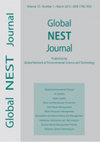沸石和活性炭结合生物处理技术去除垃圾渗滤液和生活污水中的金属
IF 1.2
4区 环境科学与生态学
Q4 ENVIRONMENTAL SCIENCES
引用次数: 9
摘要
研究了粉状活性炭和粉状沸石增强SBR技术对垃圾渗滤液和城市污水中重金属的去除效果。该研究在6台2000毫升的破碎机(工作尺寸为1200毫升)中进行。反应器分为2组,分别为活性炭增强型sbr (PAC-SBR)和粉状沸石增强型sbr (PZE-SBR)。采用响应面法(RSM)和中心复合设计(CCD)来解释自变量(曝气率(l min)、反应时间(h)和渗滤液-废水混合比(%;v/v)及其响应(因变量包括Fe、Mn、Ni和Cd)。结果表明,PZE-SBR的去除率高于PAC-SBR。PZE-SBR在接触时间(13.83 h)、曝气率(2.81 l min)和渗滤液与生活污水比例(20.00%)的最佳条件下,对Fe、Mn、Ni和Cd的去除率分别为65.65%、61.56%、63.41%和60.44%。本文章由计算机程序翻译,如有差异,请以英文原文为准。
Zeolite and activated carbon combined with biological treatment for metals removal from mixtures of landfill leachate and domestic wastewater
Current study was carried out to investigate the heavy metals removal from landfill leachate and urban wastewater by powdered activated carbon and powdered zeolite augmented SBR technique. The research was carried out in six 2000 mL breakers (working size was 1200 ml). The reactors were parted into 2 groups covering 3 for activated carbon augmented SBRs (PAC-SBR), and 3 for powdered zeolite augmented SBRs (PZE-SBR). The response surface methodology (RSM) and the central composite design (CCD) were employed to explain the most advantageous settings of the independent variables (aeration rate (l min), reaction time (h), and leachate-to-wastewater mixing ration (%; v/v) and their resopnses (dependent variables including Fe, Mn, Ni and Cd). The results indicated that the PZE-SBR showed higher performance in removal efficiencies while compared to PAC-SBR. At the optimum conditions of contact time (13.83 h), aeration rate (2.81 l min) and leachate to domestic wastewater proportion (20.00%) for the PZE-SBR, the removal efficiencies for Fe, Mn, Ni, and Cd were 65.65%, 61.56, 63.41%, and 60.44%, respectively.
求助全文
通过发布文献求助,成功后即可免费获取论文全文。
去求助
来源期刊

Global Nest Journal
环境科学-环境科学
CiteScore
1.50
自引率
9.10%
发文量
100
审稿时长
>12 weeks
期刊介绍:
Global Network of Environmental Science and Technology Journal (Global NEST Journal) is a scientific source of information for professionals in a wide range of environmental disciplines. The Journal is published both in print and online.
Global NEST Journal constitutes an international effort of scientists, technologists, engineers and other interested groups involved in all scientific and technological aspects of the environment, as well, as in application techniques aiming at the development of sustainable solutions. Its main target is to support and assist the dissemination of information regarding the most contemporary methods for improving quality of life through the development and application of technologies and policies friendly to the environment
 求助内容:
求助内容: 应助结果提醒方式:
应助结果提醒方式:


